 Hartlepool Sports & Leisure
Hartlepool Sports & Leisure
- Cinemas, Theatres & Dance Halls
- Musicians & Bands
- At the Seaside
- Parks & Gardens
- Caravans & Camping
- Sport
 Hartlepool Transport
Hartlepool Transport
- Airfields & Aircraft
- Railways
- Buses & Commercial Vehicles
- Cars & Motorbikes
- The Ferry
- Horse drawn vehicles
 A Potted History Of Hartlepool
A Potted History Of Hartlepool
- Unidentified images
- Sources of information
- Archaeology & Ancient History
- Local Government
- Printed Notices & Papers
- Aerial Photographs
- Events, Visitors & VIPs
 Hartlepool Trade & Industry
Hartlepool Trade & Industry
- Trade Fairs
- Local businesses
- Iron & Steel
- Shops & Shopping
- Fishing industry
- Farming & Rural Landscape
- Pubs, Clubs & Hotels
 Hartlepool Health & Education
Hartlepool Health & Education
- Schools & Colleges
- Hospitals & Workhouses
- Public Health & Utilities
- Ambulance Service
- Police Services
- Fire Services
 Hartlepool People
Hartlepool People
 Hartlepool Places
Hartlepool Places
 Hartlepool at War
Hartlepool at War
 Hartlepool Ships & Shipping
Hartlepool Ships & Shipping

Robinson (Kell - Smith) Family Album
Details about Robinson (Kell - Smith) Family Album
A selection of family photographs kindly shared with this project by John Robinson and Ellen Scott.
Location
Related items () :
 1954 Drawing Office staff - Colin Oglesby
1954 Drawing Office staff - Colin Oglesby
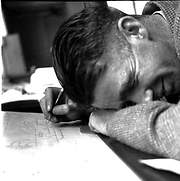 Donated by Mr. John Robinson
Donated by Mr. John RobinsonDated 1954
Richardsons Westgarth draughtsman Colin Oglesby in 1954 - made a mistake perhaps?
More detail » 1954 Drawing Office staff - Dave Judkins
1954 Drawing Office staff - Dave Judkins
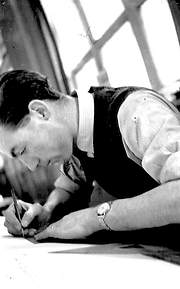 Donated by Mr. John Robinson
Donated by Mr. John RobinsonDated 1954
Richardsons Westgarth draughtsman Dave Judkins in 1954.
More detail » 1954 Drawing Office staff - Jack Watson
1954 Drawing Office staff - Jack Watson
 Donated by Mr. John Robinson
Donated by Mr. John RobinsonDated 1954
Richardsons Westgarth drawing office Section Leader Jack Watson in 1954.
More detail » 1954 Drawing Office staff - John Robinson
1954 Drawing Office staff - John Robinson
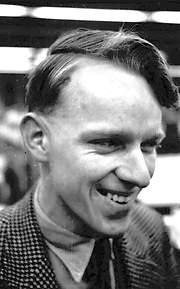 Donated by Mr. John Robinson
Donated by Mr. John RobinsonDated 1954
John Robinson worked at Richardson Westgarth from 1949 to 1963. Due to the uncertainties of work, John then left to work for English Electric in Rugby. After four years in Rugby, he emigrated to Canada and worked for the next 30 years as a consulting engineer until retirement in 1997.
More detail » A Troublesome Seven
A Troublesome Seven
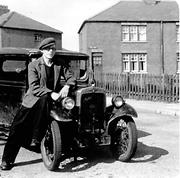 Created by John Robinson
Donated by John Robinson
Created by John Robinson
Donated by John RobinsonDated 1952
To get from Hartlepool to his work in Fishburn, Jim Robinson bought a second-hand Austin 7 car for £65 in 1952. The engine used to seize up and Jim would strip it down and fix it overnight in time to go to work next day. The generator used to overheat and melt the solder on the commutator wiring thus losing all electrical power to the car. He kept a hand cranked generator in the glove compartment and used to hand crank this while driving to keep the car running until he could re-solder the wires.
 A Visit to Vane Tempest Colliery
A Visit to Vane Tempest Colliery
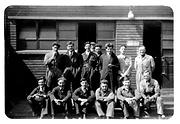 Donated by Mr. John Robinson
Donated by Mr. John RobinsonDated 1957
John Robinson (seated far right on the front row), and others in a group of Higher National Students from Hartlepool Technical College visiting Vane Tempest Colliery at Seaham in 1957. Visiting various industries was part of the course. The course lecturer is standing immediately behind John.
More detail » A touch of glamour
A touch of glamour
 Created by John Robinson
Donated by John Robinson
Created by John Robinson
Donated by John RobinsonJim Robinson's wife Doris striking a pose on the bonnet of their Bond mini car in the 1950s.
More detail » All Aboard for Battersea
All Aboard for Battersea
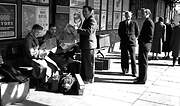 Donated by Mr. John Robinson
Donated by Mr. John RobinsonDated 1954
In 1954 a group from Richies Drawing Office were sent to do a performance test at Battersea Power Station in London. The group are (l to r): Cliff Fleetham, Arthur ?, ?, Dick Hunter and Jack Watson. Dick Hunter was the engineer in charge of the condenser and feedheater design.
More detail » An evening out
An evening out
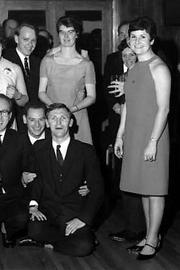 Created by unknown
Donated by Mr. John Robinson
Created by unknown
Donated by Mr. John RobinsonFormer Richrdson Westgarth apprentice Fred Gook (centre, kneeling), and his wife Pat (nee Ward) both from Hartlepool. Pat was secretary to one of the RW directors, Bernard Wyatt. Fred worked as an engineer in the condenser and feedwater heating department. Standing behind Fred are myself (John Robinson) and my wife Ann.
More detail »
 At the Paddling Pool (1)
At the Paddling Pool (1)
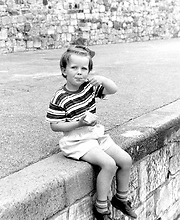 Donated by Mr. John Robinson
Donated by Mr. John RobinsonDated 1964
Jane Robinson enjoying a tub of ice-cream at the Block Sands Paddling Pool on Hartlepool Headland in 1964.
More detail » At the Paddling Pool (2)
At the Paddling Pool (2)
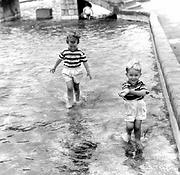 Donated by Mr. John Robinson
Donated by Mr. John RobinsonDated 1964
Jane and Paul Robinson splashing about in the Block Sands Paddling Pool in 1964.
More detail » At the Paddling Pool (3)
At the Paddling Pool (3)
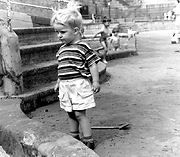 Donated by Mr. John Robinson
Donated by Mr. John RobinsonDated 1964
Paul Robinson at the Block Sands Paddling Pool in 1964 - he might need his spade to carry out some repairs on the pool steps!
More detail » Baptism - 1962
Baptism - 1962
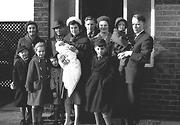 Created by Billy Robinson
Donated by John Robinson
Created by Billy Robinson
Donated by John RobinsonDated 1962
A group photograph of the Robinson family about to set off for the baptism of John and Anne's son Paul, at Holy Trinity Seaton Carew in 1962. Holding baby Paul is Mary Robinson, wife of John's brother Harry and formerly a secretary at "Richies". The photographer was Billy Robinson.
More detail » Billy and Billy at the Tea Shop
Billy and Billy at the Tea Shop
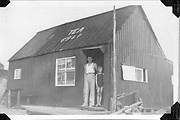 Donated by Mr. John Robinson
Donated by Mr. John RobinsonBilly Gregson and youngster Billy Robinson standing in the doorway of Ellen Kell's confectionery/tea shop hut at Hart in 1930.
More detail » By the Breakwater
By the Breakwater
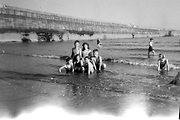 Donated by Mr. John Robinson
Donated by Mr. John RobinsonDated 1948
John Robinson and his cousins enjoying a day on the beach next to the breakwater on Hartlepool Headland in 1948.
More detail » By the Pier (1)
By the Pier (1)
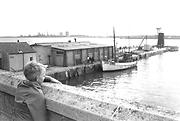 Created by Mr. John Robinson
Donated by Mr. John Robinson
Created by Mr. John Robinson
Donated by Mr. John RobinsonDated 1970
A young Paul Robinson by the Pilot Pier in 1970.
More detail » By the Pier (2)
By the Pier (2)
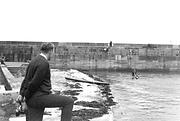 Created by unknown
Donated by Mr. John Robinson
Created by unknown
Donated by Mr. John RobinsonDated 1970
John Robinson looks on as kayakers prepare to take to the water in 1970.
More detail » Checking things out
Checking things out
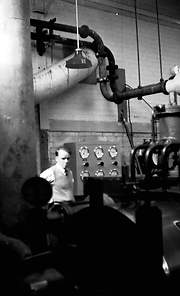 Donated by Mr. John Robinson
Donated by Mr. John RobinsonJohn Robinson keeping an eye on things in 1962.
More detail » Cyclists
Cyclists
 Donated by Mr. John Robinson
Donated by Mr. John RobinsonThe cyclists in the picture are left to right: Jim Robinson, Cliff Sorensen, Harry Robinson and Tommy Kell. Cliff, Harry and Tommy were at that time (mid to late 1940’s) apprentices at Richardson Westgarth. At this time, Tommy and Harry were members of a Hartlepool cycling club and Jim occasionally would join them in their rides. They often cycled to Billingham to swim at the baths. What they had not realised on the first visit was that Harry could not swim; he saw them in the pool treading water and thought they were standing and jumped in and Jim had to rescue him.
More detail » Dave and Audrey Judkins
Dave and Audrey Judkins
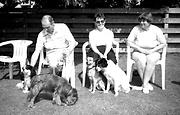 Created by Jim Robinson
Donated by John Robinson
Created by Jim Robinson
Donated by John RobinsonDated 1990
Dave was born in Hartlepool in 1924, and married Audrey Pugh in 1950. He attended school with my uncle Tommy Kell and served his apprenticeship at Richardson Westgarth. He was a lifelong friend of my uncle, and my brother's Harry and Jim Robinson. I also worked with him for five years in the drawing office. The photograph was taken in 1990, with Dave, his wife Audrey (center) and Doris Robinson (Jim's wife).
More detail » Donkey ride at Crimdon
Donkey ride at Crimdon
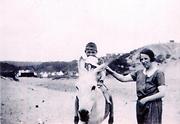 Created by unknown
Donated by Mr. John Robinson
Created by unknown
Donated by Mr. John RobinsonDated 1936
Eveline Robinson and her children Jim and Ellen Robinson enjoying a day at the beach at Crimdon in 1936.
More detail » Ellen Kell - a few notes
Ellen Kell - a few notes
Ellen Kell, a widow, had successfully supported herself and her family from the time her husband died, at a young age in 1908, by operating a small shop selling baked goods in Trimdon Colliery and a summer tea shop on Hart Sands. The Trimdon shop closed in 1936. The Hart tea shop also closed about 1936, when they were forced to move from beach area to the headland, which was a bad location, not profitable.
In 1936, the family moved from Trimdon to 11 South Road, Hartlepool, to live with daughter Jennie, a nurse at the Hartlepool hospital. Jennie married and moved to Nunthorpe.
Ellen moved across the street to 14 South Rd., a larger house, with sons Ozzy and Tommy. Here she kept boarding house until retirement age. She also had an arrangement with local bakers to make and decorate wedding cakes etc. (very artistic designs with delicate lace work and roses).
More detail » Ellen and Ozzy
Ellen and Ozzy
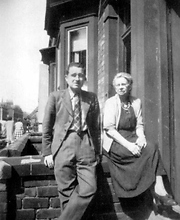 Donated by Mr. John Robinson
Donated by Mr. John RobinsonDated 1950
Ellen Kell (1882-1966) and her son Joseph Osborne (Ozzy) Mortimer (1916-1964), outside their South Road home in 1950.
More detail » Ellen with Harry and Tommy
Ellen with Harry and Tommy
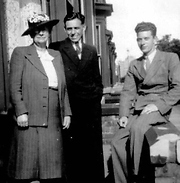 Donated by Mr. John Robinson
Donated by Mr. John RobinsonDated 1950
Ellen Kell (nee Shorthouse), with her nephew Harry Robinson (centre), and son William Thomas (Tommy) Kell, outside the home at South Road, Hartlepool, in 1950.
More detail » Fish and Chips
Fish and Chips
 Donated by Mr. John Robinson
Donated by Mr. John RobinsonDated 1948
After a busy day at the beach, John Robinson and his cousins enjoy fish and chips on the rough grass between the beach and St. Hilda's Church - now landscaped gardens. 1948.
More detail » Graduation Day
Graduation Day
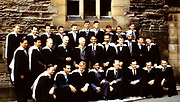 Created by Eveline Robinson
Donated by John Robinson
Created by Eveline Robinson
Donated by John RobinsonDated 1957
Hartlepool graduates Lois Searle (fourth from right, centre row) and John Robinson (fourth from right, front row), photographed outside Durham University (Castle) by John's mother Eveline Robinson. Both studied for their Degrees at Sunderland Technical College and graduated in July 1957.
More detail » Hannah Robinson at the Tea Shop
Hannah Robinson at the Tea Shop
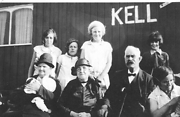 Donated by Mr. John Robinson
Donated by Mr. John RobinsonDated 1930
Hannah Robinson (back, far right), standing behind an unknown family group outside her grandmother's tea-shop hut in 1930.
More detail » Hilda Russell and her Aunt Annie
Hilda Russell and her Aunt Annie
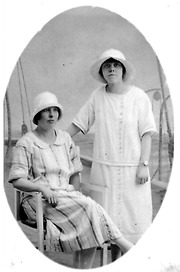 Donated by Mr. John Robinson
Donated by Mr. John RobinsonDated 1925
This is a 1925 photograph (probably taken in a studio with a painted backdrop of a ship at sea), of Hilda Shorthouse, daughter of Tom and Charlotte Shorthouse (formerly Charlotte Russell), and her Aunt Annie Shorthouse.
More detail » Hitch-hiking Apprentices
Hitch-hiking Apprentices
 Created by Marianna Gluge
Donated by John Robinson
Created by Marianna Gluge
Donated by John RobinsonDated 1953
"Richies" Apprentices Clifford (Cliff) Smith (left), and John Robinson hitch-hiking on the Isle of Skye in 1953. The photograph was taken by Marianna Gluge, a French student from Nice.
More detail » In the Dunes at Crimdon Dene
In the Dunes at Crimdon Dene
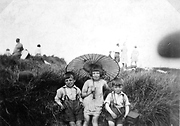 Donated by Mr. John Robinson
Donated by Mr. John RobinsonDated 1930
Harry, Hannah (with a very nice parasol), and Jim Robinson in the dunes at Crimdon Dene in 1930.
More detail » James and Alice Russell (1)
James and Alice Russell (1)
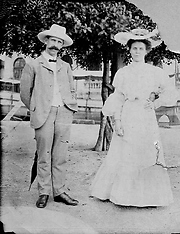 Donated by Mr. John Robinson
Donated by Mr. John RobinsonAn early photograph, probably taken in the early 1900s, of James Steele Russell and his wife Alice Hart Russell (nee Hedley). They lived in Carlton St. West Hartlepool, but it is possible this photograph was taken when James was working in Hong Kong.
More detail » James and Alice Russell (2)
James and Alice Russell (2)
 Donated by Mr. John Robinson
Donated by Mr. John RobinsonDated 1904
James and Alice Russell with their son. This photograph was dated on the back 1904 and endorsed to Charlotte Russell “ With love from Jack and Polly, May 1904”.
More detail » Joan Mortimer - Baptism in 1946
Joan Mortimer - Baptism in 1946
 Donated by Mr. John Robinson
Donated by Mr. John RobinsonDated 1946
A happy group standing outside All saints Church, Stranton, after the baptism of their Ozzy and Vera Mortimer's first daughter Joan in 1946. From left to right are: Gladys Kell (Ozzy's sister-in-law), with daughter Florence, Tommy, Ellen Kell and her sister Annie Shorthouse (holding baby Joan), and Vera. Gladys Kell (nee Bushby) was a nurse who worked with Jennie Kell at Hartlepool General Hospital, and had married Harry Kell, Ellen's son.
More detail » Joe Craggs - baker
Joe Craggs - baker
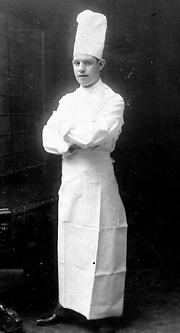 Donated by Mr. John Robinson
Donated by Mr. John RobinsonDated 1945
The Craggs family lived by the seawall near the Hartlepool (Middleton) Ferry. Joe was a baker and this photograph of him was taken in 1945.
More detail » John Robinson - Apprentice Fitter Certificate
John Robinson - Apprentice Fitter Certificate
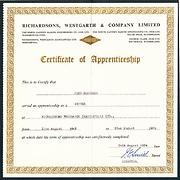 Created by Richardsons Westgarth
Donated by Mr. John Robinson
Created by Richardsons Westgarth
Donated by Mr. John RobinsonDated 1954
John Robinson's Certificate of Apprenticeship awarded after serving five years as a Fitter.
More detail » Joseph Mortimer and Vera Nossiter - 1944
Joseph Mortimer and Vera Nossiter - 1944
 Donated by Mr. John Robinson
Donated by Mr. John RobinsonDated 1944
Joseph Osborne Mortimer married Vera Frances Nossiter in 1944 at All Saints Church, Stranton. Next to Ozzy are his sister Olive and brother Tommy. Next to Vera are her sister and parents.
More detail » Land Army Girl Doris Morgan
Land Army Girl Doris Morgan
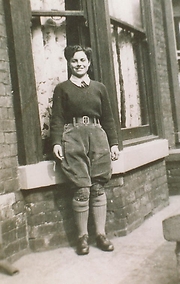 Donated by Mr. John Robinson
Donated by Mr. John RobinsonDated 1945
Doris Morgan (later Robinson), in her Land Army uniform in 1945.
More detail » NCME - John Robinson
NCME - John Robinson
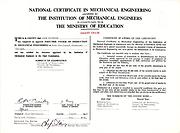 Created by NCME
Donated by Mr. John Robinson
Created by NCME
Donated by Mr. John RobinsonDated 1954
The National Certificate in Mechanical Engineering awarded to John Robinson in 1954.
More detail » NCTEC - John Robinson
NCTEC - John Robinson
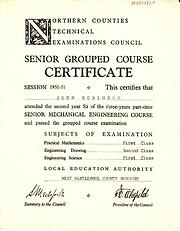 Created by NCTEC
Donated by Mr. John Robinson
Created by NCTEC
Donated by Mr. John RobinsonThe Northern Counties Technical Examinations Council Certificate awarded to John Robinson in 1951.
More detail » Nephew John
Nephew John
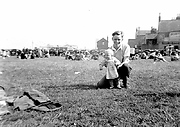 Donated by Mr. John Robinson
Donated by Mr. John RobinsonDated 1950
John Robinson and his young nephew, also John, on the grass at Seaton Carew in 1950.
More detail » Notes on the Russell Family History
Notes on the Russell Family History
The following notes were compiled by Mr. John Robinson:
William Thomas (Tom) Shorthouse married Charlotte Russell on July 10th, 1902, at Holy Trinity Church in Throston. Tom was boarding in Cleveland Road Throston and working as a Hotel Barman. Charlotte was living with her sister in Clifton St Throston. Her parents were in Stranton.
Tom and Charlotte had a daughter Hilda in 1905, their residence at that time was Arch Street, Throston. Sadly Charlotte died in 1907 in Hartlepool. Tom did re-marry, served in the Durham Light Infantry during WW1 and died in 1967 in Newcastle (still a bartender).
Hilda had an interesting story. She married and emigrated to Australia in the 1950’s. Her husband left her and she got a job as a lady in waiting for Sir William Slim's wife (the Governor General of Australia 1953-1959) and moved with them between Kiriibili House in Sydney (where she enjoyed swimming during time off) and Government House Canberra. After this she returned to England for the rest of her life.
More detail » Nurse Jenny Kell
Nurse Jenny Kell
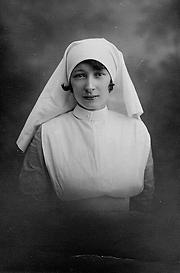 Donated by Mr. John Robinson
Donated by Mr. John RobinsonDated 1930
In 1936, Ellen Kell and her family moved from Trimdon to live with her daughter Jenny, a nurse at Hartlepool Hospital, at 11 South Road, Hartlepool. Jenny later married and moved to Nunthorpe. This photograph was taken in 1930.
More detail » Off for a hike
Off for a hike
 Created by Mr. John Robinson
Donated by Mr. John Robinson
Created by Mr. John Robinson
Donated by Mr. John RobinsonDated 1957
Hart Road school teacher Ellen Robinson (later Scott), setting off for a week's hiking on the Isle of Skye in 1957.
More detail » On the Dockside
On the Dockside
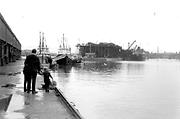 Created by unknown
Donated by Mr. John Robinson
Created by unknown
Donated by Mr. John RobinsonJohn Robinson with his son Paul and daughter Sarah, on the docks in 1970.
More detail » On the Fish Quay
On the Fish Quay
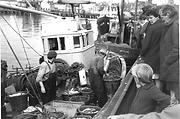 Created by unknown
Donated by Mr. John Robinson
Created by unknown
Donated by Mr. John RobinsonDated 1970
Young Sarah Robinson checks a local fishing boat's catch in 1970.
More detail » On the Grass at Seaton Carew
On the Grass at Seaton Carew
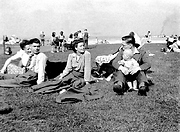 Donated by Mr. John Robinson
Donated by Mr. John RobinsonDated 1950
1950. Jim Robinson (on the right) with his son John and wife Doris (nee Morgan) in the centre, who lived in Thornton Street and joined "The Land Army" during WW2. Later, they had a nursery school "Robins Nest" on Westbourne Road. Jim was a prominent sailor and member of the Teesside Sailing Club (Middleton) and won many races including National Championships.
More detail » Out in the Field (1)
Out in the Field (1)
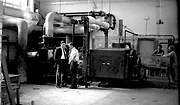 Donated by Mr. John Robinson
Donated by Mr. John Robinson In 1962 Richies supplied a small turbo-generator to I.C.I. Dyestuffs Division in Manchester. On the left is Bill Pickens (After Sales Service), and Bill Boyes (Field Erector).
More detail » Ozzy and his Uke
Ozzy and his Uke
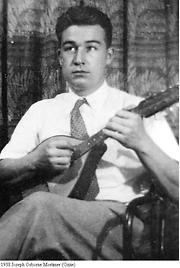 Donated by Mr. John Robinson
Donated by Mr. John RobinsonDated 1938
Joseph Osborne 'Ozzy' Mortimer playing his mandolin in 1938.
More detail » Playtime at Seaton
Playtime at Seaton
 Donated by Mr. John Robinson
Donated by Mr. John RobinsonDated 1950
Jim Robinson and his baby son John playing on the grass at Seaton Carew in 1950.
More detail » Richardsons Westgarth Office Party - 1962
Richardsons Westgarth Office Party - 1962
 Donated by Mr. John Robinson
Donated by Mr. John RobinsonDated 1962
'Richies' 1962 Office Party. Mr. & Mrs. John Robinson are on the far left of the photograph.
More detail » Richie's Apprentices at Whitby
Richie's Apprentices at Whitby
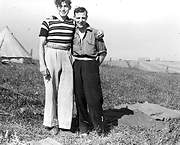 Donated by Mr. John Robinson
Donated by Mr. John RobinsonDated 1952
Apprentices Bruce Lindsay (left), and Jack from Wallsend at the Richardsons Westgarth summer camp at Whitby in 1952.
More detail » Richie's Summer Camp at Whitby
Richie's Summer Camp at Whitby
 Donated by Mr. John Robinson
Donated by Mr. John RobinsonDated 1952
Richardsons Westgarth organised a camp for apprentices each summer during the works annual holiday shutdown. This was an inexpensive holiday and open to apprentices from the four constituent companies. This is the 1952 camp at Whitby.
More detail » Richies Whitby Camp - 1952
Richies Whitby Camp - 1952
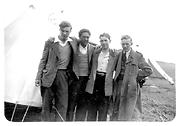 Donated by Mr. John Robinson
Donated by Mr. John RobinsonDated 1952
The Richardson Westgarth Apprentice Camp, Whitby, 1952. Left to right are: ?, Terry Harrison, Bruce Lindsay and John Robinson. Terry and Bruce worked in the Boiler Drawing Office and John in the Condensing and Feedwater Drawing Office. Terry, later, Sir Terrance, became the head of the Parsons/Rolls Royce company.
More detail » Royal Enfield
Royal Enfield
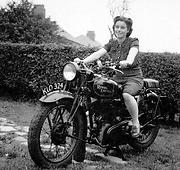 Created by John Robinson
Donated by John Robinson
Created by John Robinson
Donated by John RobinsonDoris Robinson sitting on husband Jim's 350cc Royal Enfirld motorbike, about 1951. The bike was adapted to take a sidecar.
More detail » Sorlandet (2)
Sorlandet (2)
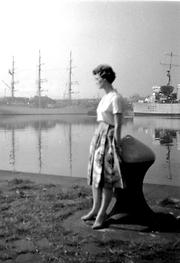 Created by John Robinson
Donated by John Robinson
Created by John Robinson
Donated by John RobinsonDated 1959
Ann Hutchinson at the coal on a sunny day in 1959. In the background is the Norwegian Sail traing ship Sorlandet, with one of the first of the 'Mothball Fleet' on the right.
More detail » Taking a Walk
Taking a Walk
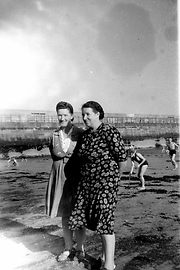 Donated by Mr. John Robinson
Donated by Mr. John RobinsonDated 1948
1948. Eveline Robinson (nee Kell, right) and Olive Burton (nee Mortimer), talking a walk on the beach while visiting their Aunt Minnie Craggs who lived on the sea wall near the Middleton Ferry.
More detail » The Craggs
The Craggs
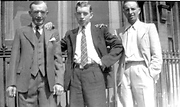 Donated by Mr. John Robinson
Donated by Mr. John RobinsonDated 1948
George, Joe and George Jnr Craggs photographed in 1948.
More detail » The Hutchinson family at Seaton Carew (1)
The Hutchinson family at Seaton Carew (1)
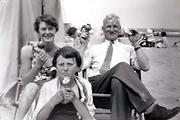 Donated by Mr. John Robinson
Donated by Mr. John RobinsonDated 1955
A photograph of Bill Hutchinson and his daughters Ann and Kathleen on the beach Seaton Carew in 1955. The family (who lived in Fishburn), were on a trip organised annually by the Fishburn Working Mens Club. People did not dress casually to go to the beach, they wore their Sunday best.
More detail » The Hutchinson family at Seaton Carew (2)
The Hutchinson family at Seaton Carew (2)
 Donated by Mr. John Robinson
Donated by Mr. John RobinsonDated 1955
A photograph of Bill Hutchinson with his wife Winnie and daughter Kathleen at the Seaton Carew Bus Station in 1955. The family (who lived in Fishburn), were on a trip organised annually by the Fishburn Working Mens Club. People did not dress casually to go to the beach, they wore their Sunday best.
More detail » The Hutchinson family at Seaton Carew (3)
The Hutchinson family at Seaton Carew (3)
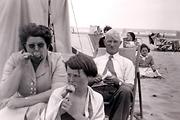 Donated by Mr. John Robinson
Donated by Mr. John RobinsonDated 1955
A photograph of Bill Hutchinson, his wife Winnie and their daughter Kathleen, enjoying toffee apples on the beach Seaton Carew in 1955. The family (who lived in Fishburn), were on a trip organised annually by the Fishburn Working Mens Club. People did not dress casually to go to the beach, they wore their Sunday best.
More detail » The Hutchinson family at Seaton Carew (4)
The Hutchinson family at Seaton Carew (4)
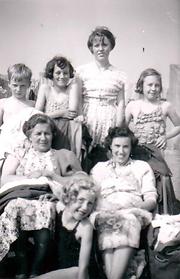 Donated by Mr. John Robinson
Donated by Mr. John RobinsonDated 1955
Kathleen Hutchinson (the tall girl at the back), with friends on the beach Seaton Carew in 1955. Kathleen's family (who lived in Fishburn), were on a trip organised annually by the Fishburn Working Mens Club.
More detail » The Hutchinson family at Seaton Carew (5)
The Hutchinson family at Seaton Carew (5)
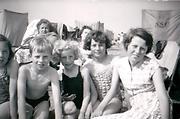 Donated by Mr. John Robinson
Donated by Mr. John RobinsonDated 1955
Kathleen Hutchinson (far right), and friends on the beach Seaton Carew in 1955. Kathleen's family (who lived in Fishburn), were on a trip organised annually by the Fishburn Working Mens Club.
More detail » The Martins
The Martins
 Created by John Robinson
Donated by John Robinson
Created by John Robinson
Donated by John RobinsonJohn and Anne Robinson's next-door neighbours John (Jack) Martin and his wife Patrica (Pat, nee Hodgson)) with son Phillip in Lawson Road. Jack had been a joiner but changed career to Insurance agent, Pat was the local midwife who delivered my son Paul in 1962.
More detail » The Story of Fred Craggs (Kell)
The Story of Fred Craggs (Kell)
The following has been compiled by family member John Robinson, who now lives in Canada:
Fred Kell (Craggs) was born 22 July 1919, an illegitimate son of Ellen Kell of Commercial Street, Trimdon Colliery, Co Durham. He was baptised 31 July 1919 in the Primitive Methodist Church, Wingate Circuit. His father is unknown.
Ellen did not have an easy life, her first husband died leaving her with three young children; she remarried and had another two children. Her second husband died in WW1 and when applying for widow’s benefits she was denied as her husband was a bigamist and her marriage ruled illegal. The family lived in a two-roomed terrace house with the bedroom upstairs divided by a curtain. To support herself and her five children, Ellen had started a front room confectionary from which she sold home baked goods. She also took in washing and scrubbed floors to make ends meet. This lifestyle continued through the depression years until 1935 when she moved with her remaining family to West Hartlepool.
When Fred was born in 1919, Ellen gave him to her sister Minnie Craggs to bring up as one of her own children. Minnie and her husband George had left Trimdon and moved to Old Hartlepool where they had a house on the sea wall near the Lifeboat station. Fred was never told about his birth mother, when his adoptive mother Minnie died in 1955, he discovered a copy of his birth certificate in a St Bruno tobacco tin. He was so surprised that he rushed over to Harry Robinson’s house to show him what he had found. He was absolutely stunned to realise that his birth mother was his aunt Ellen Kell.
What is surprising is that there were older siblings in both families that knew the true story of his birth but no one had told him. The families lived in the same community and were reasonably close but the subject was never brought up in conversation. We are sure there was never any formal adoption, just one sister helping the other out in tough times.
From what Harry told me, after Minnie died, Fred decided to go to London to find employment and a new life. We suspect that after his funds ran out he just drifted into vagrancy. It would only be about four or five years after Minnie’s death that he met Anton Wallich-Clifford.
In the late 1950's he was a vagrant with no fixed abode, a "down and out" in London. He was featured in the Book "No Fixed Abode" by Anton Wallich - Clifford, founder of the Simon Community (planning of Simon started in September of 1963).
From current published information, Simon define themselves as a community of homeless people and volunteers living and working together in a spirit of acceptance, tolerance and understanding.
They exist as a community to reach out to, support and campaign for people who are homeless or rootless, and particularly those for whom no other provision exists.
For over 40 years the Simon Community has worked to alleviate the isolation of rough sleepers, provide a place where they can gain a sense of belonging and foster the skills they need to move towards independent living.
The book “NO FIXED ABODE” was first published in 1974. The book has the following dedication:
To my mother, Bunch, Luke and Sally
for sharing some of the pilgrimage with me,
and to Fred Kell, wherever he may be,
on behalf of the homeless and rootless everywhere.
An extract from this book highlights Fred’s life as a vagrant and his part in the formation of the Simon Community.
Even after his probation order had expired Robin continued to visit me until I left the Service, but by the time I came to start Simon I had lost track of him, so he will not know that he was one of those who can be held responsible for ultimately forcing me to act on my own. Another man, however, at least knows that he was influential in what happened afterwards, even if we have never been able to give him the permanence and stability he so badly needs. More important to him is his pride in the fact that he introduced me to the Golborne Centre - and therefore to the Rev. Bram Peake, Tommy Gifford and Colin Calder.
Seen shambling along the Strand or sitting on a park bench, Fred Kell (as I first knew him) is unmistakably a 'tramp'. He fits the popular - and largely false - image from the broken peak of his greasy cap to his flip-flapping, cracked and untied boots. The top coat that he wears permanently, once brown but now compost-coloured, is sometimes belted with string; its frayed edges trail almost to his ankles. Beneath the cap his face juts out like a badly carved meerschaum pipe, and from behind his steel framed spectacles (which he is always losing) his eyes sadly survey the scene in a constant search for fag-ends.
When he first climbed the narrow, twisting stone staircase to the probation office in Broadcourt Chambers he had arrived back in London from one of his many trips. Although a seasoned wayfarer, he had not previously sought assistance from us; but knowing what he wanted, he had shrewdly guessed that, in his penniless condition, and at an hour when he could expect only a Sally Ann (Salvation Army) bed chit from the NAB - a probation officer's help might be more effective.
Poor Jo Knox must have groaned to herself as she opened the door to him and put him in the 'tank', for when she called me on the intercom she said 'It's one of your’s Anton - on tappers', and added as a cautionary note 'probably lousy, so watch your chairs!'
Some moments later Fred shuffled into my room. At my invitation he flopped on to the fireside chair like some gaunt, moulting bird of prey descending on a bough, and in one movement taloned the proffered cigarette and produced a mouth-organ from his bulging pocket.
'This is my mouth-organ' he introduced himself, or rather the instrument which he waved in front of me. 'I don't beg. I'm Fred, Fred Kell and I play this in pubs. I works my way around, I'm known all over the place. I've just got back from my home in Northampton, you know - and I wonder if you can help me?'
He drawled out the short sentences in a heavily accented voice that sounded as though he thought he was puffing and blowing on the mouth organ; and in fact as he gasped to a stop he quickly blew a little tune. 'Like it?' he asked, and before I had made any reply he launched into an account of his travelling years playing his way from town to town.
Eventually I gathered that the purpose of his visit was to see if I would 'give him a bed chit for the Golborne Centre. 'I know Dr Peake' he said. 'I've been to his Centre before. He's a very nice man. The Doc'll help me. I'm not going to a bloody doss-house. It's just that I haven't any cash right now. But I'll get some. I'll play in a few pubs. It's just that a note would help. He's always very full, you know, but if I have a chitty from you I'll be all right.'
He puffed to a stop, and then played another little tune, watching to see my reaction. 'If you know Mr Peake and you've been there before, why didn't you go straight there?' I countered. "Well, it's a place for ex-cons, you know. I've done some bird. That's how I went there first, but he won't take casuals. You have to be referred. That's why I thought you might refer me'.
The wily old bird has it all sewn up, I thought, but secretly I was delighted, because although I had collected several cuttings about the Golborne Centre I still had not traced its exact whereabouts. I knew vaguely that it was in the Notting Hill area, and that it was a church which the pastor had converted into a sort of half-way house for discharged prisoners. In official circles it was looked upon with some suspicion because of its sensational publicity, and I was still too new and inexperienced in the daily search for beds to have made any serious attempt to locate or use it. I had an opportunity thrown right into my lap. I could give Fred a note and a bed voucher, and if his confidence was as justified as he made out, I would have an excellent case for 'home visiting' a 'voluntary supervision' case.
This in fact is exactly what happened, for Fred left happily, puffing and blowing 'I'll take you home again, Kathleen', armed with his official note and bed ticket, and the following evening, on his very precise and careful directions, I found myself entering the church doorway of the Golborne Centre for the first time. There I met Tom Gifford, at that time Warden, with his assistant, Colin Calder, and of course a jubilant and contented Fred Kell. It was only some days later that I actually met the rumbustious and exuberant Rev. Dr B.E. Peake DD* ('I got my DD by correspondence with an American evangelical college'), and began a relationship with the Centre, Bram, his wife, children and staff which was to lead to my eventually cramming his unique and never-to-be-forgotten 'hostel-in-a-church' with homeless Bow Street clients to the almost total exclusion of other agencies. From that first moment, I knew that Golborne, and Bram Peake's system of 'con boss' leadership, house meetings and do-it-yourself home-from-home kit, provided the answer to the problem which I was fast realising would be my biggest headache at Bow Street. From our initial meeting something clicked; but neither of us realised then that in time his warm, natural and amateur attempts to make life bearable for the homeless offender within the confines of his tiny Free Congregational Church would grow to the point where he would set up a trust of which I became a member, and that I would write the booklet 'One Man's Answer'* about him and his work.
Fred himself settled down for a few weeks before again being drawn irresistibly back on the road in his fruitless search for identity. He always ended up in Northampton because that was the town in which he had been born some forty-five years before. He could remember his mother very well, and with deep affection, but almost everything else had been blotted out in the intervening experiences of children's homes, rootless wanderings in search of work, army service, short spells in prison and the endless post-war miles flapping from Sally Ann to Church Army, from town to city and from hamlet to village, puffing and blowing his mouth-organ, eking out the pennies and shillings for food and a night's kip. Nothing permanent or lasting. No relationships that were meaningful. No place to settle. And now - even with his real acceptance of Golborne and its acceptance of him - he could not overcome the need to keep returning to his place of birth. So he kept on moving; but at least whenever he got back to London, if only to get his spectacles repaired or replaced, and to enjoy the companionship of Golborne, he always called to see me.
It was on one such visit that he solemnly informed me that he had changed his name to Cragge - 'It's me mother's maiden name' he said, 'and that must be my real name.' So Fred the Organ duly became Fred Cragge; and our friendship has travelled much like Fred himself down the years. He spends a few days in a Simon house of hospitality but there is no hope of rooting him. The last time I met him was with my wife, in the waiting-room at Charing Cross station last year. 'Hello, Mr. Clifford' (he never would call me Anton) he puffed, "how are you these days? I haven't got me mouth-organ. I lost it.' But nothing else had changed.
Fred, contrary to what he related to Anton, was raised in a normal family with other siblings. He had two older brothers, two younger brothers and a younger sister. Minnie’s husband George had worked as a coal miner in Trimdon but on moving to Old Hartlepool got a job as a labourer in the local shipyard. He did not always have work and went through some hard times. Minnie had been brought up as a strict Methodist and was a hard worker. Like her sister Ellen she was an accomplished baker and started to sell homemade goods from her home to supplement the family income.
Other Old Hartlepool residents remembered Fred:
He was known locally in Hartlepool as "Teacake Freddie" hawking his mothers baking around the streets.
The book "Look Back for a While" by Nick Cannon remembered Freddie Craggs: "Fred was a happy lad, going around the Croft with a large wicker basket full of his mother's large home baked teacakes covered with a white muslin towel. These teacakes tasted delicious and very popular around the Croft."
Up until the death of his adoptive mother Minnie, Fred had led what we would call a fairly normal life. The families in Hartlepool and Trimdon were in fairly close contact with each other, Fred was part of this larger family group.
Jim Robinson (nephew) recalled:
Grandma Kell had the tea shop in the dene at Hart (Crimdon), the family in the depression years camped there during the summers. Fred was a constant visitor, he walked along the sands from and to Hartlepool. He also often walked from Hartlepool (12 miles) to visit his cousin (half sister) Eveline Robinson in Trimdon Village, she always gave him busfare for the trip home.
He at one time worked as an Eldorado Ice Cream man. Used to come all way from Hartlepool to Trimdon on the Ice Cream Bike. Sadly it took so long the ice cream used to melt away. He used to have his birth certificate in a little tin box and was always showing it to people and telling them that his Aunt Nellie was his mother. He used to wander about the town on a Saturday hoping to see someone in the family, and expected them to give him some money.
The males in the Craggs family were social drinkers, son George had an excellent voice and sang many of the popular classical pieces. He mainly sang as an entertainer in pubs around Hartlepool, passing the hat to earn a few pounds. Fred obviously had a good example to follow with his mouth organ.
Of course he was never in “children’s homes” and his roots were in Hartlepool not Northampton. During the time he was meeting with Anton, his birth mother and most of his siblings, and adoptive siblings, were alive and could have helped him in his situation. Apparently he was always a “happy-go-lucky” type of person and his assumed lifestyle must have made him content. We are not aware that he made any contact with the family during his excursions; Hartlepool is a long walk from London.
We believe that Fred died in London, July Quarter, 1990 in the Lambeth District. Anton died 30 July 1978 aged 55 from cancer.
More detail »
 Three Draughtsmen
Three Draughtsmen
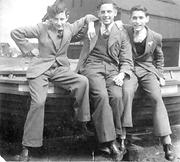 Donated by Mr. John Robinson
Donated by Mr. John RobinsonDated 1950
Three Richies draughtsmen. The man in the centre is Mr. J. H. Stonebank at the time living in Blackhall Colliery and now residing in Chelmsford, Essex, the names of the men either side are not known. The photograph is taken from the the boiler drawing office sitting on a boat outside the old lifeboat station at the Middleton Ferry c.1950.
More detail » Tom and Charlotte Shorthouse
Tom and Charlotte Shorthouse
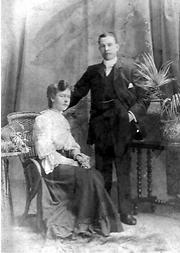 Donated by Mr. John Robinson
Donated by Mr. John RobinsonDated 1902
A wedding picture of William Thomas (Tom) Shorthouse and Charlotte Russell, who were married on July 10th, 1902 at Holy Trinity Church in Throston. Tom was boarding in Cleveland Road Throston and working as a Hotel Barman. Charlotte was living with her sister in Clifton St Throston. Her parents lived in Stranton.
More detail » Tommy Kell in Kuwait
Tommy Kell in Kuwait
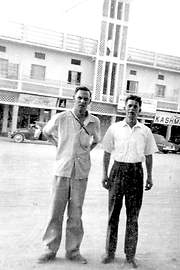 Donated by Mr. John Robinson
Donated by Mr. John RobinsonDated 1960
1960. Tommy Kell (left), was a gas turbine erector at this time working on the units exported to Kuwait. Tommy started as an office boy in 1940, completed his apprenticeship as a fitter, joined the Merchant Navy as an Engineering Officer, returned to RW as an erector on gas turbines (mostly overseas).
 Tommy Kell in uniform
Tommy Kell in uniform
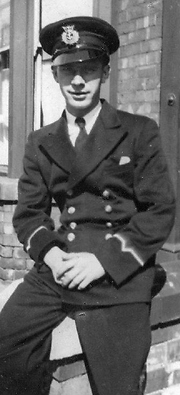 Donated by Mr. John Robinson
Donated by Mr. John RobinsonDated 1948
1948. When Tommy Kell finished his apprenticeship he joined the Merchant Navy as an Engineer Officer.
More detail » Tough Times During the Depression
Tough Times During the Depression
 Donated by Mr. John Robinson
Donated by Mr. John RobinsonDated 1930
The Depression caused great hardship across the country. In 1930, Eveline Robinson camped with her children at Hart (Crimdon Dene), for most of the summer. Here she is holding baby John behind a group of children including her own three, Hannah, Billy and Jim.
More detail » Upgrade to an Eight
Upgrade to an Eight
 Created by John Robinson
Donated by John Robinson
Created by John Robinson
Donated by John RobinsonDated 1954
Sometime around 1954, Harry Robinson replaced his 350cc Royal Enfield motorbike with a Morris 8 motor car, pictured here with his young son David.
More detail » Wedding of Harry Robinson to Mary Smith
Wedding of Harry Robinson to Mary Smith
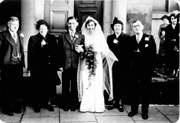 Donated by Mr. John Robinson
Donated by Mr. John RobinsonDated 1951
The 1951 wedding of Harry Robinson (Turbine Engineer), to Mary Smith, the Technical Director’s secretary. Mary’s father, John Smith also worked at Richardson Westgarth's in the toolshop.
More detail »



